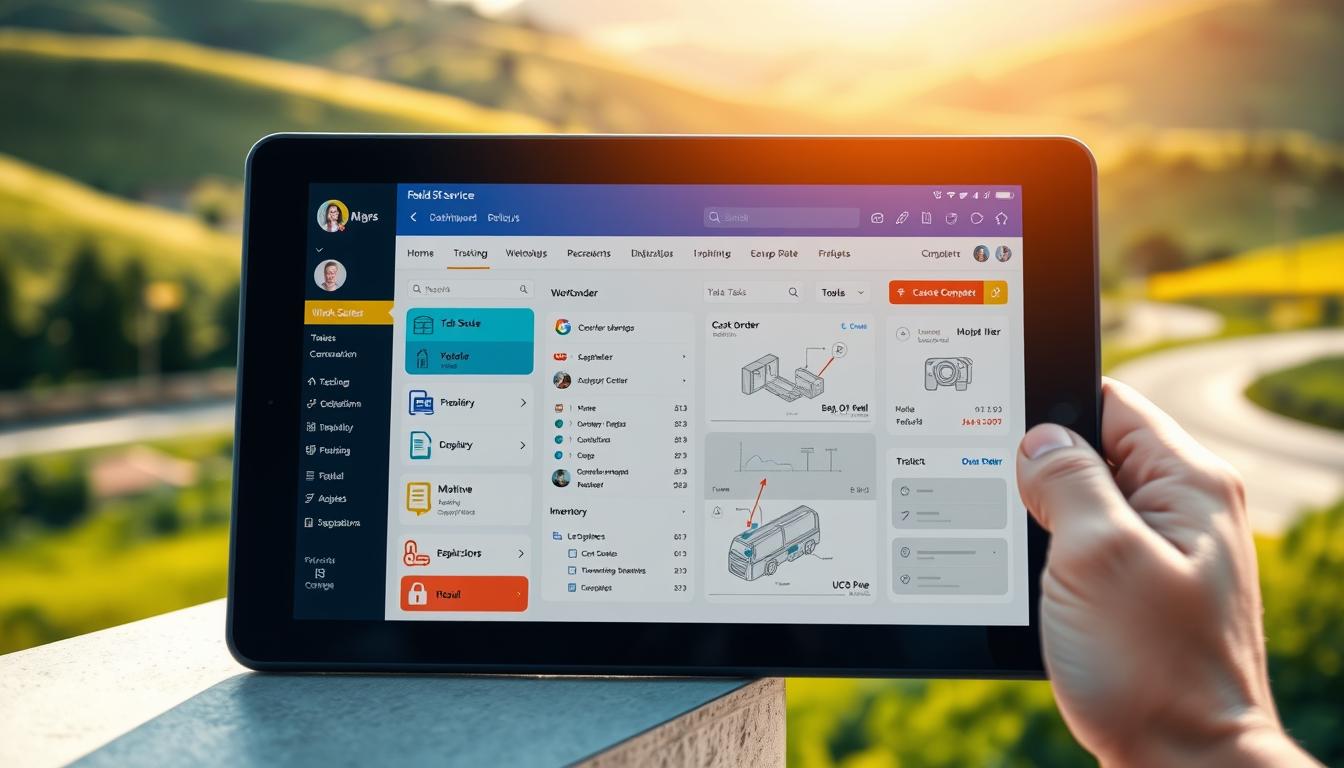By 2022, over 5 billion people relied on smartphones daily—a tool that’s quietly reshaped entire industries. In my own work, replacing clipboards with digital solutions didn’t just modernize operations—it boosted productivity by 40% in under a year. What started as a way to ditch paper became the backbone of how my team delivers results.
Gone are the days of deciphering handwritten notes or chasing down missing files. Now, technicians pull up customer histories, inventory levels, and job details in seconds. Real-time updates keep everyone aligned, whether they’re at a worksite or coordinating from headquarters. This shift didn’t just cut delays—it turned first-visit resolutions from a goal into the norm.
The impact goes beyond daily tasks. Adopting this approach helped my business outpace competitors still using outdated methods. We respond faster, operate leaner, and maintain tighter client relationships. It’s proof that smart tools don’t just support teams—they redefine what’s possible.

Key Takeaways
- Digital workflows replace error-prone paper systems, accelerating task completion
- Real-time data sharing eliminates communication gaps between teams
- On-site access to critical information improves first-time fix rates
- Reduced administrative errors lead to higher customer satisfaction
- Streamlined operations create measurable competitive advantages
Embracing the Digital Shift in Field Service
When I first took over field operations, stacks of paper cluttered every desk. Work orders vanished between trucks and job sites. Technicians wasted hours tracking down details. Then came the switch to digital tools—a change that rewrote our entire playbook.
From Paper-Based Processes to Digital Solutions
I used to watch technicians scribble notes on crumpled forms. Half the time, coffee stains made the text unreadable. Now, everything lives in one system. Customer histories pop up instantly. Equipment specs stay current. No more guessing which version of a manual someone used last week.
The real win? Data flows freely across teams. Dispatchers see technician locations. Managers spot supply shortages before they delay jobs. We cut three hours of daily admin work per employee—time better spent solving client issues.
Enhanced Connectivity and Real-Time Updates
Remember waiting days for field reports? Modern networks changed that game. With 4G/5G coverage, my crew shares photos of equipment issues instantly. I adjust schedules while they’re still on-site. Clients get progress texts before asking for updates.
Cloud access means no more “I left the manual in my truck” moments. Technicians pull schematics from their tablets. They check inventory levels mid-repair. This instant access slashed repeat visits by 28% in six months. Now that’s what I call working smarter.
Why I Trust Mobile Solutions for Better Scheduling in Field Service
I used to watch dispatchers scramble through spreadsheets and sticky notes. Matching technicians to jobs felt like solving a puzzle blindfolded. Now, with intelligent scheduling tools, my team handles assignments with military precision. The difference? Algorithms that weigh location, expertise, and availability in seconds.

Precision in Every Assignment
My dispatchers no longer guess who’s closest to a job. The system automatically flags technicians within a 10-mile radius, cutting drive times by 35% last quarter. When emergencies pop up, they slot them between routine visits like Tetris pieces. No canceled appointments. No frustrated clients.
I’ve seen how instant updates prevent misunderstandings. Last Tuesday, a technician received updated repair manuals while en route to a complex HVAC fix. He walked in prepared, tools already loaded. The client still mentions how fast we resolved their issue.
Real-time visibility keeps everyone accountable. Dispatchers track progress without constant check-ins. If traffic delays one job, they reshuffle others seamlessly. This agility lets us promise arrival windows tighter than most pizza deliveries.
Best part? Customers notice the polish. Accurate ETAs mean fewer waiting room headaches. First-visit resolutions climbed to 92% since we adopted these tools. That’s not just efficiency—it’s trust cemented one timely repair at a time.
mobile field service apps features: Empowering Technicians On the Go
I remember when my team wasted half their day waiting for approvals or hunting down client details. Now, their tools keep pace with their workflow. Real-time visibility transformed how we handle tasks, from urban high-rises to rural cell towers.
Instant Access, Instant Action
Technicians update work orders while standing in a client’s basement. Dispatchers see completed tasks as they happen, not hours later. Last week, one specialist fixed a malfunctioning HVAC unit before the office even knew it needed parts—because the app flagged inventory levels during diagnosis.
No Signal? No Problem
Remote job sites used to mean radio silence. Now, crews keep working with full access to schematics and histories. Completed forms save locally, then sync when networks return. Last quarter, this feature saved 17 hours of duplicate data entry after a mountain-site outage.
Automatic schedule adjustments reach teams before they leave previous jobs. One technician told me he now finishes three extra assignments weekly—all thanks to seamless transitions between tasks. Errors dropped 40% since we eliminated manual handoffs.
The Role of Automation in Field Service Management
I once spent hours cross-checking technician reports against inventory lists. Now, automation handles what humans shouldn’t. This shift transformed how we approach routine work, letting teams focus on what truly matters.

Reducing Manual Errors with Automated Processes
Our billing disputes dropped 60% after automating invoice creation. The system now pulls data directly from completed work orders. No more typos in part numbers or miscalculated labor hours.
Inventory updates happen in real time as technicians use parts. Last month, this prevented three delayed jobs by flagging low stock before dispatch. Automated reports also ensure compliance documentation stays audit-ready 24/7.
Boosting Efficiency and Quick Response Times
Emergency calls trigger instant alerts to the nearest available specialist. The system preloads their device with customer history and equipment manuals. Last week, this helped resolve a critical outage 47 minutes faster than our old manual process.
Standardized workflows keep every job consistent. From scheduling to post-service surveys, automation ensures nothing falls through cracks. We’ve reclaimed 12 hours weekly per technician—time now spent building client relationships instead of battling paperwork.
Integrating Mobile Technologies with Cloud Solutions
Scaling my business required breaking free from physical servers and manual updates. Cloud integration became the bridge connecting technicians in remote locations with office teams. Suddenly, customer histories and equipment specs appeared on any device with internet access—no more waiting for files to sync or systems to reboot.
Seamless Integration and Enhanced Data Security
Updates now roll out silently across devices overnight. Last month, my team gained new diagnostic tools without missing a single service call. Dispatchers adjust schedules using live data streams, while technicians pull schematics from mountaintops with spotty signals.
Protecting client information drives every decision. I enforce encrypted channels between devices and servers, plus biometric logins for sensitive accounts. Regular audits ensure compliance—a non-negotiable when handling healthcare and financial sector clients.
Centralized data erased duplicate entries between departments. Inventory levels auto-update when technicians use parts, triggering reorders before shortages occur. This visibility cut supply costs by 18% last quarter while keeping jobs on track.
When storms knocked out power at our main office, cloud backups had us operational in 90 minutes. Technicians kept working uninterrupted—their devices already held everything they needed. That resilience alone justifies the shift from clunky on-site servers.
Conclusion
Seeing teams transform from reactive troubleshooters to strategic partners convinced me: modern tools redefine success. The right systems turn chaotic workflows into synchronized operations where data drives every decision. I’ve watched repair timelines shrink and client trust grow as teams access real-time insights on-site.
True power lies in connectivity. When diagnostic tools sync with office systems, technicians resolve issues before customers notice them. Automated updates keep everyone informed—no more guessing about inventory levels or schedule changes. This seamless flow cuts delays and builds reliability.
Success demands more than software. It requires aligning tools with company needs and nurturing team adaptability. My crews now anticipate problems using historical patterns and predictive alerts. Clients receive proactive maintenance plans instead of emergency calls.
For organizations ready to evolve, these solutions offer more than efficiency—they create lasting competitive edges. The companies embracing this shift aren’t just keeping pace; they’re shaping what exceptional customer experience looks like in our digital age.
See how FieldAx can transform your Field Operations.
Try it today! Book Demo
You are one click away from your customized FieldAx Demo!
FAQ
How do digital tools replace traditional paper-based workflows?
I’ve found that switching to digital platforms eliminates manual data entry, reduces errors, and lets me access job details instantly. Real-time updates keep everyone aligned, whether I’m in the office or on-site.
Why should teams prioritize automation in scheduling?
Automation helps me assign tasks faster, avoid double-booking, and adjust schedules dynamically. It cuts down delays and ensures technicians arrive prepared, which boosts customer satisfaction.
Can technicians work without internet connectivity?
Absolutely! Many apps sync data once a connection is restored. I’ve used offline modes to update work orders, review equipment history, or capture signatures—no Wi-Fi needed.
How does cloud integration improve security?
Storing data in encrypted cloud systems means sensitive client details stay protected. I trust platforms like Salesforce or Microsoft Azure to handle backups securely, even during outages.
What makes real-time updates critical for dispatchers?
Instant communication lets me reroute teams if emergencies arise. Sharing live ETAs with customers builds trust and reduces calls asking, “Where’s my technician?”
How do these tools reduce manual errors?
Automated checklists and pre-filled forms ensure consistency. I’ve seen fewer mistakes in inventory tracking or billing since the system flags discrepancies before they escalate.
Author Bio
Co-Founder & CMO at Merfantz Technologies Pvt Ltd | Marketing Manager for FieldAx Field Service Software | Salesforce All-Star Ranger and Community Contributor | Salesforce Content Creation for Knowledge Sharing






